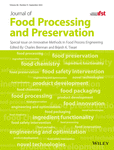Nutritional, antinutritional, and functional properties of different processed (soaking, germination, and boiling) flour from moringa oleifera lam (moringa) seed
Abstract
In view of prevalent food shortages in most developing countries, attention is currently being drawn to the exploitation of underutilized and unconventional plant resources. Nutritional, antinutritional and functional properties of unprocessed and processed flours from moringa (Moringa oleifera Lam.) seeds were investigated in this study. Moringa oleifera lam. seeds were processed (soaking SMSF, germination GMSF, and boiling BMSF) hygienically and thoroughly dried and milled into flours, standard methods of analyses were used to ascertain the nutritional, antinutritional, and functional properties. The results revealed that processed seed flour significantly increase (p < .05) the nutritional composition and functional properties with GMSF with highest value of protein content (32.13%) but a significant (p < .05) decrease was observed in antinutritional properties (ranging from 15.74 mg/100 g to 36.90 mg/100 in tannins, 2.03 g/100 g to 2.99 g/100 g in saponins, 0.09 mg/100 g to 1.68 mg/100 g in cyanogenic glycoside) of all moringa (SMSF, GMSF, and BMSF) seeds flours when compared to the unprocessed (UMSF) seed flour. The results obtained in this study showed that the processing methods especially germination and soaking treatments were more effective in improving nutrient bioavailability, nutrient density and reduced antinutritional factor of the seeds, thus, suggesting that these seed flours can be incorporated into food because it contained the essential nutrients needed by the body to function well, and besides they are accessible and affordable when compared to the conventional food. Furthermore, they could serve as another source of protein.
Novelty impact statement
This study showed that this underutilized and unconventional moringa seeds especially the one processed (germination and soaking treatments) were more effective in improving nutrient bioavailability, nutrient density, and reduced antinutritional factor of the seeds, thus, suggesting that these seed flours can be incorporated into food because it contained the essential nutrients needed by the body to function well. Furthermore, they could serve as another source of protein.




